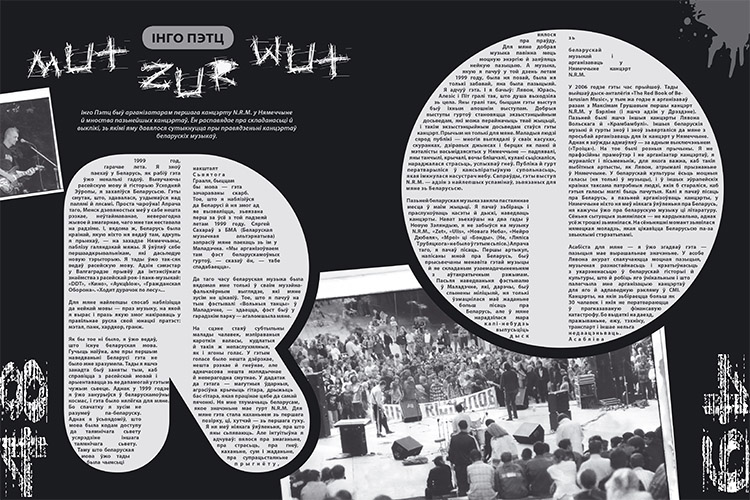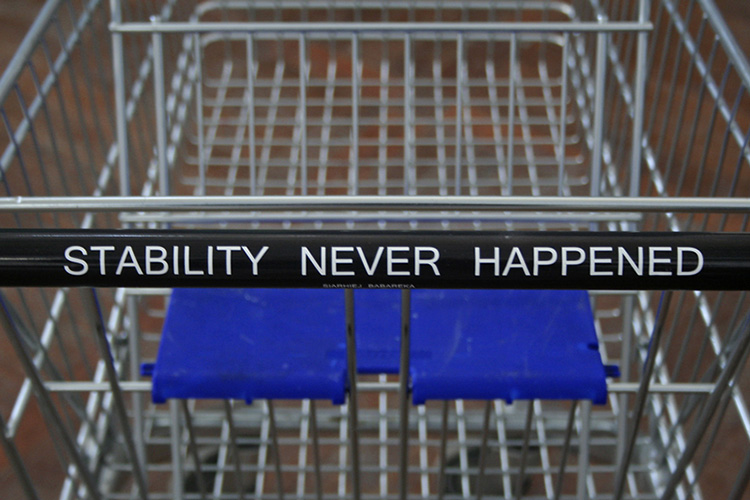
Аўтар: pARTisan, 28/08/2014 | ART Cult Aktivist project SPECIAL
MANIFESTA 10: IN FACT THEY’RE COLONIZED
On June 28, 2014 The European Biennial of Contemporary Art Manifesta10 was launched in St. Petersburg, according to some opinions — the biggest and most controversial art event of the year (according Russian media). St. Petersburg was selected as the venue for this year’s Biennale, partly due to the 250th anniversary of the Hermitage.
In the course of preparations for Manifesta, a number of political events occurred in Russia, among which passing legislation against homosexual propaganda, the introduction of the whole package of censorship limitations, the annexation of Crimea and others, becoming a reason for some artists’ calls to boycott the Biennale. Nevertheless, Manifesta 10 did take place.
Tania Arcimovič (critic, «pARTisan» media project editor,), Alaksiej Barysionak (critic, «ArtAktivist» editor) and Volha Šparaha(philosopher, «New Europe» editor) share their impressions about the Biennale, about the strategy of (non) participation (if we can use such tactics speaking about Belarus?), also trying to reflect on the reasons why Belarus is not present in Manifesta.
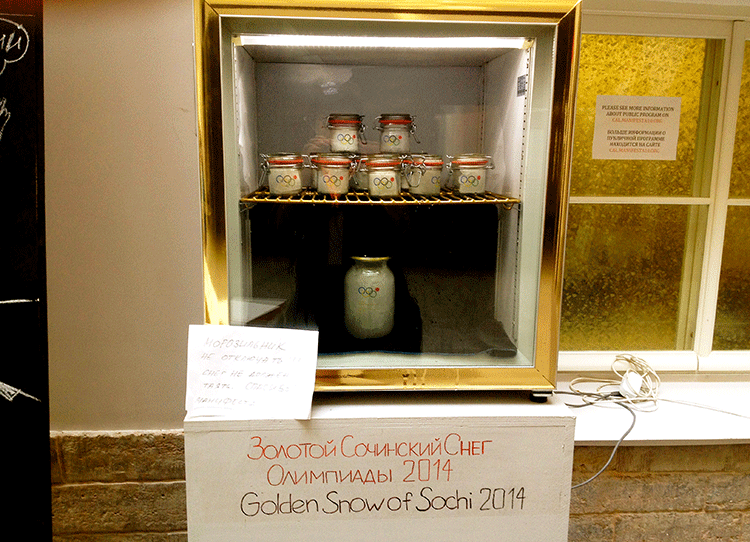
An installation of The Public program
Tania Arcimovič: Let me start, recalling Ekaterina Degot’s words about the political statement of Manifesta10. On the one hand, actually it has turned out to be missing: the event, as other critics also noted, was left unnoticed by the public of St. Petersburg. Thus, were there the dialogue preconditions the Biennale curators had mentioned? Did they really succeed in shaking up the conservative city of St. Petersburg? I do not think so. While attending the exhibition in the General Staff, I was mostly struck by the emptiness – both in literal and figurative ways. There was actually no public present there, and those who I saw were mostly foreigners. Although we all know that Palace Square and the Winter Palace are the most popular city destinations.
Nevertheless, Manifesta was a sort of isolated: if this is the voice of Europe which appeals to reason and judgment, it, in my opinion, sounds lonely, it cannot be heard, and this fact reveals certain helplessness.
On the other hand, and here I would agree with Degot again, political implications are really present, but in a sense which was defined by the Manifesta’s main curator Kasper König, who called it «Manifesta without a manifesto». Although, if he speaks about it in a rather politically correct way, for me it is, as I have said earlier, a statement of helplessness. In addition, whether the curators wanted or not, but in the end they have managed to expose, making visible such hidden processes of the Russian state and society as total bureaucratization, society’s conservation, (self)censorship, and so on. In particular, highlighting the crisis of Manifesta itself. Also, it was very strange to get to know König’s opinion that art was not politics. The second part of his statement sounds like «art does not exclude politics». But the mere fact of the separation of these two dimensions in the context of rethinking politics, which takes place in contemporary humanitarian circles, is surprising.
Alaksiej Barysionak: I would start our discussion with the venue of Manifesta. Not so long ago I came across Michail Ryklin’s text, where he describes the Moscow Metro not just as a transportation or technical construction, but as a complex machine with a variety of discursive practices — technical, ideological, symbolic, and others.
The Hermitage presents a similar example of such a monstrous machine. Now it is not just a building, where the royal family once lived or where a museum is located now, but a complex space with any dialogue hardly possible in it.
That is why the choice of this place seems strange to me, taking into account the fact that Manifesta is celebrating its 20th anniversary and the Hermitage – its 250 years. It is surprising that such a crucial Biennale chooses the celebration format and merges into a single unit with the place of admiration of art and culture, which is the Hermitage.
On the other hand, it was interesting to hold such a Biennale in Russia. Because before that, only one Manifesta had been organized in a post-socialist country. At the same time it would be interesting to hold it, for example, at the Exhibition of National Economic Achievements — within the space, which is currently undergoing some major changes: it has lost its ideological function and become a place of commerce, still remaining a large exhibition complex with lots of empty halls. Such a site might have been changed into a space where it would be possible to think about the functions of large exhibitions today, about the content and the ways of presentations set in them.
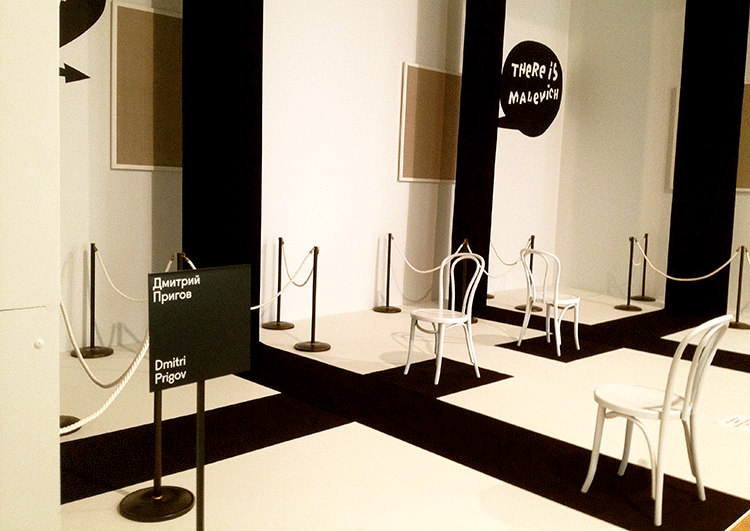
The installation by D.Prigov
I was also surprised by Menke’s text presented in the catalogue. There are many types of a conceptual language one can adopt when speaking about art and politics, for example, Rancière’s approach. As for Menk, he uses phenomenological optics, according to which art is not a part of society or a social practice, in general. Manifesta10 also claimed certain art autonomy, and this fact refers rather to the issues of late modernism.
Thus, König says that art does not exclude itself from politics and participation, and introduces specific projects in the exhibition, but at the same time, he brings these practices into the state of art autonomy, pushing them into a framework which they in fact are trying to fight.
I have another remark about König’s statements given in one of the open letters, where he says that we do not want to transform the exhibition into a platform for topical and political speculations. But, in my opinion, the opposite happened. For example, the exposition of Boris Mikhailov’s works, on the one hand, as if emphasizes the fact that we can talk about politics, that there is no censorship, but on the other hand, they just trigger certain topicality. Thus, it seems to me that the show failed because the projects that would refer to some past of the Hermitage, which would analyze its context, were not present there.
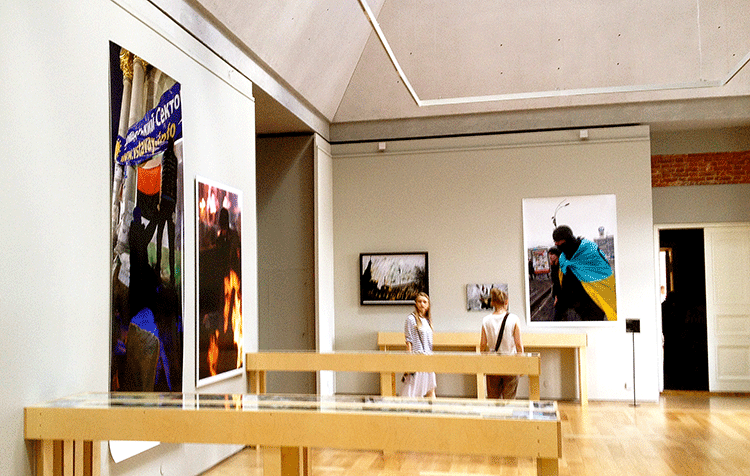
The exposition of Boris Mikhailov’s works
Volha Šparaha: I have not seen the exhibition, only read the documentation. But from what I read, it seems to me that the key phrases were «Manifesta and the Hermitage» and «Manifesta in St. Petersburg». And I believe this is the first indicator of failure, because if you read what Manifesta 10’s director Michaił Pijatroŭski writes, the idea was in discussing changes within a common public space of Europe — economically, politically and culturally. Whereas the exhibition probably showed that the discussion did not occur. Because everyone suddenly got focused on the issue of Manifesta’s intervention into the Hermitage and St. Petersburg and there were only these issues that were discussed by everyone. For me, it seemed amazing, because what I saw, for example, at the latest Documenta, in general had no connection to the venue: the challenge was to create a speculative space and thus, perhaps, to discuss speculative capitalism and the Biennale, its origins and the meaning of art etc.
And here all was localized around the exhibition, and in this respect I have a question: so what is the Manifesta’s artist statement?
On the other hand, no matter how successful or unsuccessful the intervention into the museum was, as Alaksiejnoted, the intervention could have been different, based on all the layers, which are linked to the Hermitage. What actually happened was such a spontaneous meeting of artists with the space, though all the critics and journalists note that it is good, that it did manage to shake up the Hermitage. Maybe, this experience is significant for St. Petersburg, but how comparable is it with Manifesta’s scale? This kind of intervention could have been carried out at smaller costs. But, according to what both the director and the curators write, Manifesta had a much more global agenda. If today we formulate questions about the European space included into Manifesta’s conceptual scope, perhaps now the central question deals with its changes caused by the war in Ukraine.
And my hypothesis is that this exhibition has shown that art did not even manage to put the question. Maybe, artists are not supposed to be the first ones to do it, or the Biennale itself is actually not the suitable form for such questions.
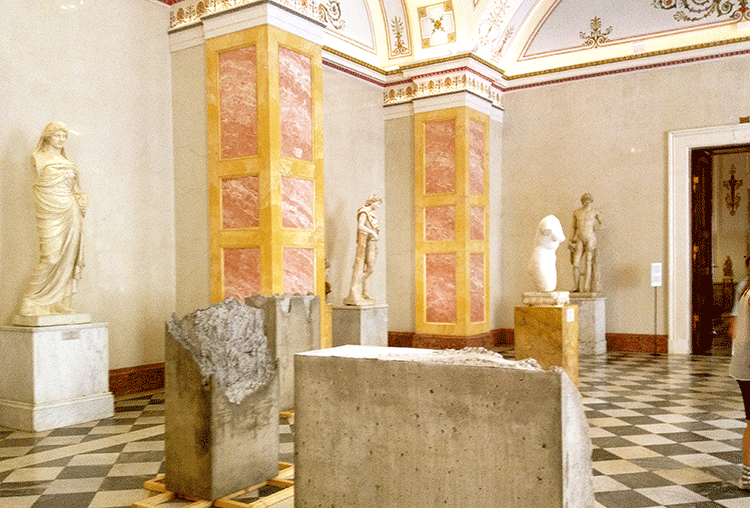
Lara Favaretto’s works in The Winter Palace
It means that Manifesta, which must be formulating questions that arise within the common European scope did not complete its mission. But it did fulfill another task, important for St .Petersburg, for Russia, for a certain segment, but it is not a Manifesta’s actual task, in my opinion.
I would also like to come back to Ekaterina Degot’s idea that she repeats in her article «A Text That Should Never Have Been Written?» where she says that today the Biennale also uses capitalist logic, because it is based on choice and the choice always refers to the commodity-money relations. I still think that the reduction of everything to a choice can be a definite option, but it is not limited to the whole diversity of both discourses and ways of life. Besides the choice, in my opinion, at the other extreme there is solidarity and community. And if Biennale also aims at generating certain forms of solidarity and community, it appears to me that we go beyond choice in such a capitalist sense. And thus we might pose a question:
what did Manifesta as a type of Bienniale do from the point of solidarity and community formation? Did it manage to get access to a wider audience, which was one of the curators’ goals?
Or they only managed to reproduce the logic of capitalism — with a choice of curators and the artists’ competition? Then it was a manifestation of the Biennale in the worst sense.
Т.А.: I would like to come back to Alaksiej’s idea about the possibility of rethinking the Hermitage’s space. Yes, it would have been correct. But to carry out such a reflection a radically different situation in the country is necessary. Rethinking processes must occur at other levels — political, historical, etc. and then it would be possible to work with the history of the Hermitage.
But we see that these processes not only failed to start, but intensive conservation of the society occurred. And, as I said, Manifesta has made it visible.
For example, Katharina Fritsch’s work entitled «Woman with Dog» placed in the boudoir of the Empress, seems to present an attempt to rethink, to show in a different way the space where the public usually comes to the delight from luxury, without reflecting on what is hidden behind this gold. But in the end, in my opinion, the critical potential of the work disappeared, only adding to the entertaining effect. The same happened with other works.
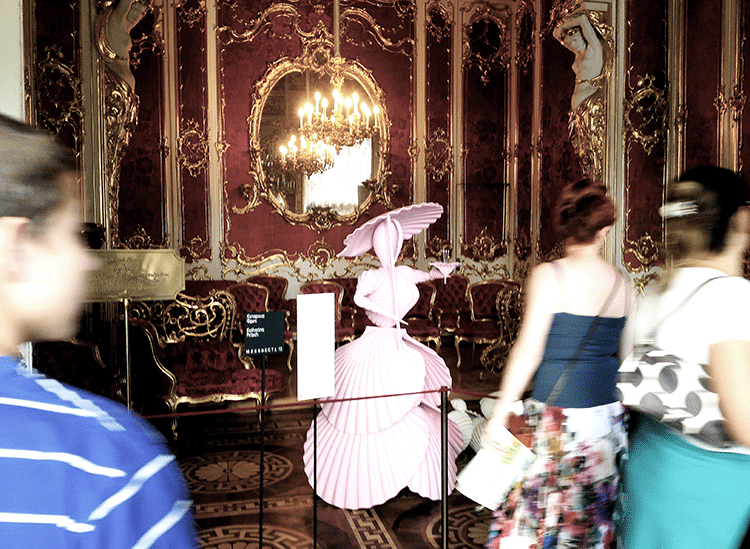
Katharina Fritsch «Woman with Dog»
What concerns König’s statement about political speculations, it is interesting that in addition to the works that directly articulate such a statement, the story itself around Manifesta 10’s preparation was connected with the political situation in Russia. Thus, at the entrance to the main exhibition there is an angle dedicated to the public program with the whole story presented there. Among the items in the list of the events there is a «Pussy Riot» lawsuit followed by the sentence about the decision to hold Manifesta 10 in St. Petersburg. Further go the statements about the adoption of law on homophobia, calls for a boycott, Putin’s claiming that Russia is not Europe, etc.
But in the end, such a direct articulation of the political aspect, in my opinion, looks like an excuse due to the pressure from the art community and calls for a boycott, as if admitting that there is not (self)censorship, etc. Consequently, there actually happened an example of speculation.
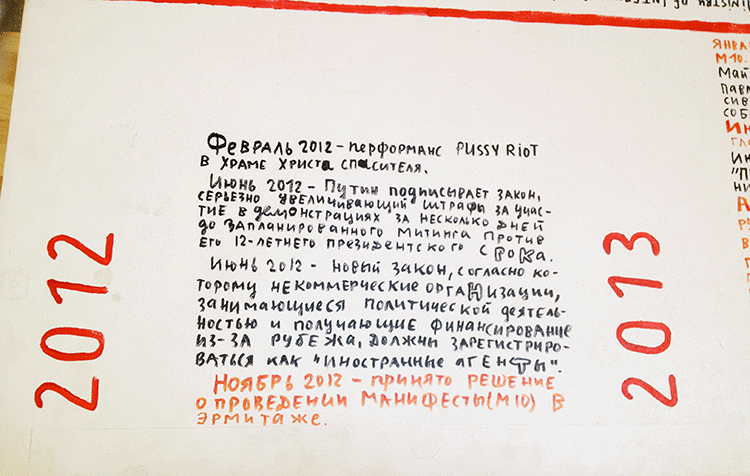
Chronicle of Manifesta10 in frame of The Public program
Here is another example — Kristina Norman installation «Souvenir» at Palace Square, which should make a reference to the Maidan. In the description of the work as well as in the comments given by the artist everything looks convincing. But in reality, the scale of the Christmas tree at Palace Square is very small and being close to the Alexander Column, in fact, it looks blank: if you do not know what it is, you might even take it for building constructions. That is, for the wider public the work is unlikely to be understandable, especially taking into consideration that already on the 5th of August it was dismantled.
А.B.: When we were on a tour with the curator’s assistant, she started almost every single presentation of art works saying how difficult it was to exhibit it, boasting that, for example, they did manage to show Joseph Beuys or Susan Philipsz and others. The hall with the Beuys’ installation was basically symbolic. Once Pijatroŭski said that Beuys would never be exhibited in the Hermitage, because he was a fascist. This statement shows a complete lack of understanding of Beuys practices, who spent the whole of his artistic life rethinking this trauma.
V. Š.: I wonder how communication with the curators and the artists in Russia itself was built. It turns out that the key figure engaged into the dialogue with the curators of Manifesta was the Hermitage director, but not other, independent, curators. And if to think about the future, about a possibility of similar events to be suddenly held in our country, we should never accept the fact that on our part, on the part of the independent, alternative scene,there would be no curator.
And in this sense, it seems to me, that what happened should be regarded as a symptom: in which ways it possible in today’s Russia to deal with contemporary art practices?
This is a sort of a show of the recognized Western art in the recognized state institution. For me this is an indicator of theconservation of the Russian society: now we will add to the Hermitage contemporary art, which has already proven itself and thus we will fill the Hermitage itself with «a new life».
«Alphabet» — a recent exhibition in Homel curated by the Belarusian artist Michaił Hulin — comes to my mind. Then it seemed to me that unfortunately, contemporary Belarusian art was presented in the traditional way. Contemporary art in the Hermitage was shown a sort of in a contemporary way, subordinated to its own rules of the game, as if saying that there, in the West, they thought that they would come to teach us, but what we did was actually to make them neatly fit our Hermitage.
It turns out that the colonial discourse gets doubled, it remains not overcome. They think of colonizing us but in fact it is us who colonize them.
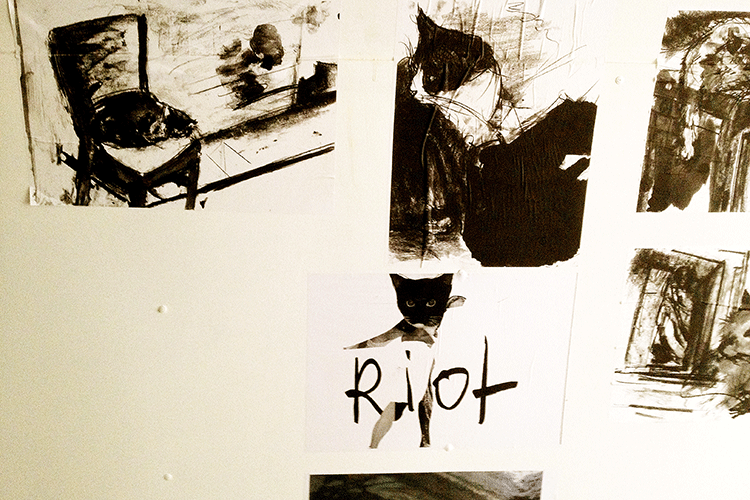
A part of the project by Erik van Lieshout
А.B.: We can talk about the public program which seems to be the most interesting to me. Once I was deeply inspired by the interview with Joanna Warsza because for her the situation was much more complicated than for König. On the one hand, she was pressed by the Hermitage institutional system, Manifesta itself, on the other — those artists she was working with and who were persuading her to refuse.
And she did give her answer — and I really appreciate the challenge, — that one thing was to make an activist Biennale in Berlin and absolutely another one was trying to form the conditions for artist statements in St. Petersburg.
In general, it is interesting to speculate about the boycott and its effectiveness. Because it is precisely those artists — I mean «Chto Delat» Group — which could, within Manifesta, pose the questions of solidarity, refused to participate. The issue of (non) participation for us, on the whole, seems to be topical, because Belarusian independent artists and curators often find themselves in a situation of such a choice. In the course of the preparation of Manifesta 10 there were several strategies: active boycotting (may be not so popular, but it was supported by some artists from Ukraine and Western Europe), as well as the strategy that has been associated with the position of Warsza and what is most interesting, in my opinion, was implemented by «Chto Delat» Group. A year ago in St. Petersburg they organized a school of engaged art — a long-term project aimed at creating a community in St. Petersburg. They refused to participate directly in Manifesta, at the same time actively organizing their activities alongside with it.
That is, if we do not have space to discuss really important issues at a high level, we can identify ourselves with the artists who share our views on what is happening in Ukraine, and to create a space of solidarity.
Obviously, the effect would be smaller, but under these conditions it was one of the most appropriate strategies.
Т.А.: What concerns (non) participation, Warsza’s position is also very close to mine, and first of all it is good for the researchers that Manifesta did take place, otherwise we would be left only to dwell on the outcomes. If to speak about the use of such practices here, this is actually what we do – we implement the «Chto Delat» strategy. We create our own alternative spaces for solidarity where it becomes possible to conduct a discussion.
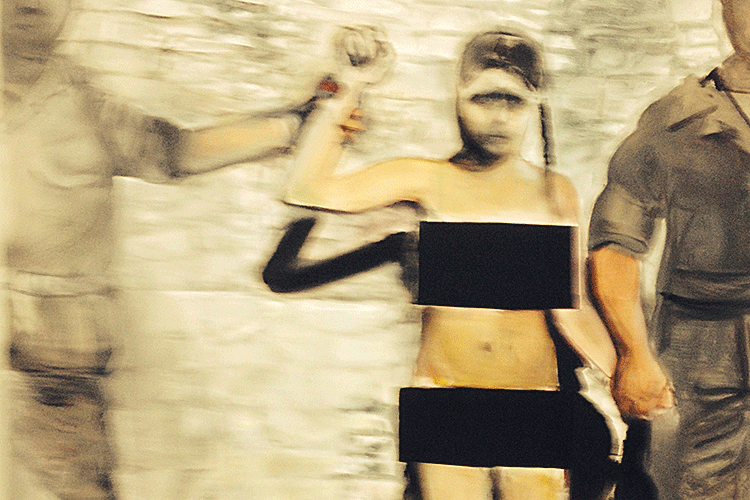
A part of oil of Marlene Dumas
А.B.: I recall Umberto Eco’s thesis who wrote that boycotting in cultural field is a complicated matter. One should understand perfectly well that often boycott and the refusal to communicate would rather lose, but at the same time they have their own power. Eco gives an example of boycotting intellectual events in Iran or, say, Israel, where it completely blocked communication possibilities. In projects similar to Manifesta, in my opinion, there is always that movable plate, and every time you need to analyze and make decisions based on the specific context.
V. Š.:So far I really have so idea about how one can participate in the projects of our public institutions. Most often, the output is a distortion of the work and the context and the birth of speculative stories. Maybe because professional, partnership or ethical standards have not been worked out or do not function here. With rare exceptions, such projects are made by independent curators, but often these are people who agree in advance to do what the state tells them to do.
Т.А.: There is another aspect which is important for us — the fact that Belarus has completely dropped out of Manifesta. I do not mean the absence of artists, since it was the choice of the curator, but if you consider that the Biennale public program is built on the reflection around the post-Soviet space and that Vitebsk railway station is chosen as the intersection point, it is surprising that in the map not a single Belarusian city is spotted. Although the road from St. Petersburg to Vilnius or any other city in Western Europe goes through Vitebsk.
It turns out that Belarus a sort of fell out of this space of reflection.
V. Š.:Yes, it is a question, but only the curator can answer it. We can only speculate. Maybe this is our fault: maybe we are not doing enough to be heard, to assert our position loud enough.
Perhaps, we are not as active as should be in appealing to the global world, for example, or in outlining our position on the same events in Ukraine.
That is a good reason for us to turn to ourselves and perhaps build our strategies differently.
Translation by Volha Bubič
Photos © pARTisan
Opinions of authors do not always reflect the views of pARTisan. If you note any errors, please contact us right away.




